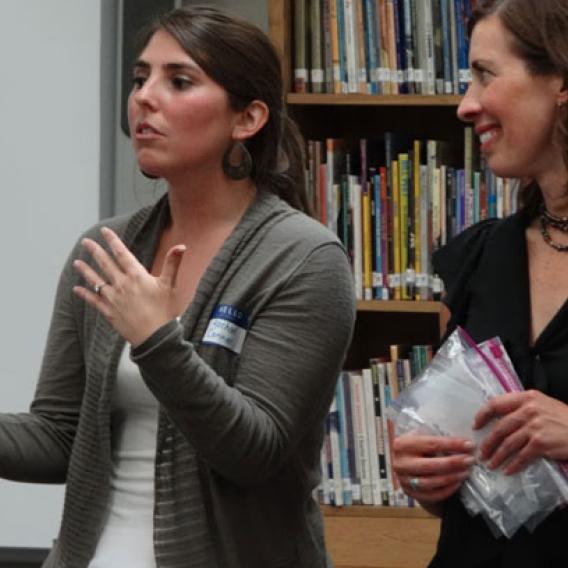Workshop 1 | Co-teaching Foundations
Workshop introduction
Workshop 1 only needs to be completed once. Workshop 2 will be repeated with each co-teaching pair.
The Co-Teaching Foundations online workshop provides background information about co-teaching with a focus on the following elements:
- Understand how co-teaching as a student model came to be
- Articulate how the co-teaching model differs from the traditional model Identify key research findings and reasons for co-teaching
- Use common language for co-teaching Implement co-teaching strategies and co-planning strategies
- Identify roles of triad members
- Offer ideas to create a welcoming environment for co-teaching
Generally, it takes 1.5-2 hours to review workshop materials and activities.
Upon completion of this workshop, you will be able to submit a short reflection form and download your CEU certificate (2 units).
What is co-teaching?
Co-teaching is defined as two teachers (teacher candidate and cooperating teacher) working together with groups of students; sharing the planning, organization, delivery, and assessment of instruction, as well as the physical space. (Bacharach, Heck & Dank, 2004)
The cooperating teacher (CT) is a classroom teacher who is willing to mentor the teacher candidate using co-teaching. The teacher candidate (TC) is a University of MN student in a licensure program.

Many teachers in our partner schools are familiar with co-teaching strategies introduced during professional development workshops for use when working with special education colleagues in the classroom. The seven strategies for co-teaching (Cook & Friend, 1995) remain essentially the same as originally implemented, however Washut Heck & Bacharach (2010) have adapted the strategies for practicing teachers to use while mentoring pre-service teachers during student teaching. The seven co-teaching strategies provide the framework for how the two teachers will engage in the shared work of planning, organizing, delivering, and assessing instruction. The classroom space and students will be shared in a way that makes it difficult for an observer to distinguish who is the teacher of record for the classroom.
What does co-teaching look like in practice? Read The Power of Two story detailing the experiences of cooperating teachers and teacher candidates during the pilot of co-teaching in 2011-12.
What is a pre-service co-teaching?
Due to state requirements for a variety of experiences at multiple levels, most secondary and K-12 programs cannot dedicate a teacher candidate to a single site for the full year placement. A pre-service math teacher, for example, must have experience at a middle school and a high school level. Therefore, most secondary and K-12 placements are between 8-14 weeks in length and occur multiple times during the academic year (fall and spring)
Co-Teaching is an attitude of sharing the classroom and students. Co-Teachers must always be thinking: “We are both teaching!” (Bacharach & Heck, 2011)
The goal of student teaching is for future teachers to experience all aspects of teaching and to become excellent classroom practitioners. With an attitude of sharing the classroom and students by co-teaching during student teaching, both the adults and students benefit.
The pre-service teacher is able to engage in the classroom more fully alongside a mentor teacher who remains actively engaged with the students as well. Unlike traditional student teaching models where the mentor teacher disengages with the classroom over a period of time, co-teaching retains the expertise and added value of the mentor teacher as an active participant with students throughout the experience. Let’s explore this shift in thinking further:

Traditional student teaching models often identify a designated period of time for the student teachers to “solo” while the new co-teaching model for student teaching uses the idea of becoming a "lead" teacher instead. Both ideas have merit for different reasons.
In a traditional student-teaching model, a teacher candidate often observes the cooperating teacher for an extended amount of time. Little by little, the candidate takes on more responsibility, eventually "solo" teaching by planning instruction, assessing student work, and managing classroom routines. Historically, the cooperating teacher does not use co-teaching strategies to teach with the candidate in the traditional model.
In co-teaching, the pair (teacher candidate and cooperating teacher) is encouraged to co-plan and quickly incorporate the co-teaching strategies in their practice, providing more opportunities for the students to engage with both adults in the classroom. The mentor teacher remains engaged, using the strategies to support student learning and engagement. The co-teaching pair collaborates throughout the experience, with leadership in responsibility and decision-making shifting over time to the teacher candidate. Ultimately, the teacher candidate assumes leadership in all aspects of the classroom, including directing the activities of the cooperating teacher and other adults working with the students, for a pre-determined amount of time. It is important that the teacher candidate does have opportunities to solo teach too, but the goal is to co-teach once the candidate has established classroom leadership skills and students interact with both adults as their teachers.
SOLO teaching vs. LEAD teaching
Print out Solo vs. Lead Co-teacher handout
The timing of when the teacher candidate fully assumes the role as lead teacher is negotiated by the triad (cooperating teacher, university supervisor, and teacher candidate) and varies by classroom and situation. The cooperating teacher and university supervisor work together to gradually scaffold the teacher candidate into assuming the lead role in co-teaching. The supervisor, cooperating teacher, and candidates (called the "triad") also pre-determines in advance the length of time that the teacher candidate serves as the lead teacher. Licensures in elementary and secondary programs may have different requirements as to how long the candidate should serve as the lead teacher. In other words, this is a shared decision between the members of the triad and will be different for each candidate.
What is co-teaching?
References
Cook, L. & Friend, M. (1995). Co-teaching: Guidelines for creating effective practices. Focus on Exceptional Children, 28(3), 1-17.
Washut Heck, T. & Bacharach, N. (2010). Mentoring Teacher Candidates Through Co-Teaching. Teacher Quality Enhancement Center. St. Cloud, Minnesota.
© 2012, St. Cloud State University. Used with permission by the University of Minnesota-Twin Cities’ Office of Teacher Education (OTE) for the CEHD Partner Network
Why co-teach?
St. Cloud State University (SCSU) trained approximately 900 classroom teacher to mentor student teachers using co-teaching as part of the five year initiative in over 40 school districts. During that time, SCSU utilized the Teacher Quality Enhancement grant to work with a large school district partner and to study student achievement and engagement in learning in both co-taught and not co-taught classrooms over a five year period. Using quantitative measures (MAPS and MCA data) and qualitative data (surveys, focus groups, observations), SCSU was able to draw comparisons and conclusions for math and reading achievement in three different types of classrooms:
- with a school district teacher - teacher candidate,
- with a traditional student-teaching model (a student teacher was working in the room but not using the co-teaching model), and
- with the cooperating teacher and teacher candidate co-teaching.
Researchers found that for both math and reading, children learning in classrooms where a teacher candidate was placed using the co-teaching model made significantly HIGHER gains than both classrooms without a teacher candidate and classrooms with a traditional student-teacher.


See Data Information Sheet and Facts Sheet documents.
Co-teaching helps to:
- reduce student-teacher ratio and enhance classroom management;
- create more instructional options for all students and increase student participation and engagement;
- Improve the academic performance of students.
- Higher gains were present in co-teaching classrooms for free/reduced price lunch eligible children, special education eligible children, and general population (overall)
- Less of an impact was present for ELLs (perhaps due to practices in co-teaching already present in ELL instruction or in the types of assessments used to track progress in ELL).
What do K-12 students say about co-teaching classrooms?
The researchers in the original grant also interviewed, surveyed, and held focus groups with K-12 students to gather data about their experiences in co-taught classrooms. Here’s what they had to say:
- More engaged in smaller groups
- Received more individual attention
- Get questions answered faster
- Get papers, assignments, and grades back faster
- Students behave better
- Fewer classroom disruptions
What are cooperating teachers saying about co-teaching?
Survey data and focus group data collected from cooperating teachers reported a high satisfaction with co-teaching, as follows:
- Ability to reach more students, particularly those with high needs (93.5%)
- Better relationship with their teacher candidate (91%)
- Experienced professional growth (89.2%)
- Enhanced energy for teaching (87.8%)
- Hosting a candidate without giving up my classroom (87.1%)
- Teacher candidate had a better experience than they would have through with a traditional model (81.7%)
What do teacher candidates say about co-teaching?
Co-teaching helped significantly improve:
- Classroom management skills (92.4%)
- Collaboration with other adults (92%)
- More teaching time (90%)
- Deeper understanding of the curriculum (89.2%)
- More opportunities for self-reflection (88.8%)
Co-teaching strategies
Co-teaching is an attitude of sharing the classroom and students. Co-teachers must always be thinking: “We are both teaching!” (Bacharach & Heck, 2011)
You need to think carefully about your co-teaching needs to make sure you select a strategy that would be right for your co-teaching classroom.
The following video is a silent overview of the different co-teaching strategies.
This video is hosted on the Vimeo video-sharing website. If this site is blocked by your school district and you cannot watch the video, please use this link to download a MS PowerPoint presentation about co-teaching strategies.
One teach, one observe
One co-teacher has primary instructional responsibility while the other co-teacher gathers specific observational information on students or the (instructing) teacher. The key to this strategy is to have a focus for the observation.
One teach, one assist
One co-teacher has primary instructional responsibility while the other co-teacher assists students with their work, monitors behaviors, or corrects assignments.
Station teaching
The co-teaching pair divides the instructional content into parts and the students into groups. Groups spend a designated amount of time at each station. Of-ten an independent station will be used.
Parallel teaching
Each co-teacher instructs half of the students. The two co-teachers are addressing the same instructional material and present the lesson using the same teaching strategy. The greatest benefit is the reduction of student to teacher ratio.
Supplemental teaching
This strategy allows one co-teacher to work with students at their expected grade level, while the other co-teacher works with those students who need the information and/or materials extended or remediated.
Alternative/differentiated teaching
Alternative teaching strategies provide two different approaches to teaching the same information. The learning outcome is the same for all students; however, the instructional methodology is different.
Team teaching
Team taught lessons that are well planned exhibit an invisible flow of instruction with no prescribed division of authority. Using a team teaching strategy, both teachers are actively involved in the lesson. From a student’s perspective, there is no clearly defined leader, as both teachers share the instruction, are free to interject in-formation, and available to assist students and answer questions.
For more information on co-teaching strategies please see:
Co-teaching roles and responsibilities
In co-teaching, the pair (teacher candidate and cooperating teacher) are encouraged to co-plan and quickly incorporate the co-teaching strategies in their practice, providing more opportunities for the students to engage with both adults in the classroom. The mentor teacher remains engaged, using the strategies to support student learning and engagement. The co-teaching pair collaborates throughout the experience, with leadership in responsibility and decision-making shifting over time to the teacher candidate.
Ultimately, the teacher candidate assumes leadership in all aspects of the classroom, including directing the activities of the cooperating teacher and other adults working with the students, for a pre-determined* amount of time.
It is important that the teacher candidate does have opportunities to solo teach too, but the goal is to co-teach once the candidate has established classroom leadership skills and students interact with both adults as their teachers. The following chart describes the typical flow of responsibilities from cooperating teacher to teacher candidate experienced while mentoring with co-teaching.
The timing of when the teacher candidate fully assumes the role as lead teacher is negotiated by the triad (cooperating teacher, university supervisor, and teacher candidate) and varies by classroom, program, and situation. The cooperating teacher and university supervisor work together to gradually scaffold the teacher candidate into assuming the lead role in co-teaching. The triad also pre-determines in advance the length of time that the teacher candidate serves as the lead teacher. Licensures in elementary and secondary programs may have different requirements as to how long the candidate should serve as the lead teacher.
The diagram below describes the roles of the cooperating teacher (CT) and the teacher candidate (TC) during the co-teaching process.
Phase I: Beginning
CT is the "instructional lead"
- Determine content to be taught
- Plan lessons and share materials with TC
- Decide what co-teaching strategy to use, with TC’s input
- Communicate with families to welcome your co-teaching TC
TC is to:
- Communicate and co-plan daily with the CT
- Engage students in learning by trying out each co-teaching strategy at least twice with your CT
- Build relationships within the school community
- Balance coursework requirements with the school’s expectations
Phase II: Middle
TC is the instructional "lead"
- Plan and lead lessons in the co-teaching team for the period of time the licensure program requires
- Communicate with CT to pre-determine which co-teaching strategies will be used in the classroom
- Complete TPA and other
CT is to
- Provide guidance regarding content and standards to be addressed
- Co-plan and support TC in their adoption of the role of instructional leader
- Engage students using pre-determined co-teaching strategy
- Provide feedback
Phase III: End
TC shares/phase out the instructional "lead"
- Share or slowly give up the lead instructional role in the co-teaching relationship
- Co-plan and co-teach using the strategies
- Complete other university requirements
- Provide feedback to the university supervisor
CT is to
- Share or slowly take back the primary responsibility of instructional lead in the co-teaching relationship
- Continue to co-plan and co-teach using the strategies
- Provide feedback to the TC and to the university supervisor
Print out the Co-Teaching Phases diagram
For more information about co-teaching roles and responsibilities please see:
FAQs
Due to state requirements for a variety of experiences at multiple levels, most secondary and K-12 programs cannot dedicate a teacher candidate to a single site for the full year placement. A pre-service math teacher, for example, must have experience at a middle school and a high school level. Therefore, most secondary and K-12 placements are between 8-14 weeks in length and occur multiple times during the academic year (fall and spring).
"The Power of Two" article is about a professional development school (PDS) elementary site where the University of MN-Twin Cities places elementary and early childhood candidates for the entire school year in the same classroom.
The timing of when the teacher candidate fully assumes the role as lead teacher is negotiated by the triad (cooperating teacher, university supervisor, and teacher candidate) and varies by classroom and situation. The cooperating teacher and university supervisor work together to gradually scaffold the teacher candidate into assuming the lead role in co-teaching. The supervisor, cooperating teacher, and candidates (called the “triad”) also pre-determines in advance the length of time that the teacher candidate serves as the lead teacher. Licensures in elementary and secondary programs may have different requirements as to how long the candidate should serve as the lead teacher. In other words, this is a shared decision between the members of the triad and will be different for each candidate.
Only one teacher candidate is placed in the classroom with a cooperating teacher for the co-teaching field experience. The co-teaching occurs between the cooperating teacher and one teacher candidate. Some UMN-TC programs place practicum (pre-student teaching) students in pairs with willing cooperating teachers for short field experiences. However, pre-student teaching placements are not co-teaching placements.
Teacher candidates in co-teaching settings are mentored using co-teaching strategies to become a licensed professional who will more likely stay in the profession. As the co-teaching findings indicate, leaving all classroom responsibilities and instruction to a student teacher without employing co-teaching as a mentoring model can not only be detrimental to the P-12 students learning and engagement, but it can frustrate the novice teachers so that they leave the profession. The cooperating teacher should work to scaffold the teacher candidate’s induction into teaching, assuring that the TC takes on more of the instructional lead role as they gain confidence and skill with P-12 students. As a profession, we must work to dispel of the idea that pre-service teachers must be left entirely on their own to sink or swim in student teaching to prove that they can teach.
It is important that the cooperating teacher works to mentor and model how to lead, build relationships, and manage classrooms rules and routines. In co-teaching, the researchers found that TCs had more opportunities to become more effective classroom leaders than they did in traditional student teaching settings. The cooperating teacher will need to make room for the teacher candidate to implement effective classroom management strategies and build confidence by creating a classroom space that assures sharing leadership of the classroom. HINTS: Discuss, as a co-teaching team who will have management responsibilities each day, so as new situations arise there are many opportunities for the teacher candidate to gain confidence with clarity about whose responsibility it is to handle the issue at that moment. Have a signal (e.g. stand under the clock, pull your earlobe, or flip over a visible item on the desk) when you or your co-teacher needs the other to step in.
Teacher candidates must have opportunities to teach alone. The amount of time a candidate is left totally alone varies and is based on their skills in managing a classroom, the type of instruction/lesson designed for the students that day, etc. It is important that the teacher candidate demonstrates that they can handle a classroom all by themselves. Drs. Bacharach and Washut-Heck recommend a 70-30 ratio with 70% of the time spent with students using co-teaching strategies to utilize both teachers’ expertise in facilitating student learning and 30% of the time spent with the TC or CT solo teaching.
In order to co-teach effectively, the cooperating teacher and teacher candidate must have shared planning time. Early in the co-teaching relationship, we recommend setting aside 1 hour a week to co-plan to co-teach. During this time co-teachers often review the curriculum and instructional goals for the upcoming week, determine which co-teaching strategies will best support students to meet the learning objectives, and decide who will be instructional lead or supporting co-teacher for each co-taught lesson. NOTE: It may take more time to co-plan in the early stages of co-teaching. However, the benefits of spending time to co-plan are exciting. Teacher candidates get a much deeper understanding of the entire curriculum through co-planning, cooperating teachers have an opportunity to share the work load with another adult, and the co-taught lessons lead to increased academic performance and engagement of P-12 students.
No, that is not true. For a period of time, each teacher candidate will lead the planning, organization, delivery, and assessment of instruction in a co-taught classroom. The teacher candidate will also be responsible for directing other adults, including the cooperating teacher, thus learning the skills necessary for effectively managing the human resources in a classroom. The teacher candidate will be the instructional lead but the cooperating teacher will be available to support learning during co-taught lessons using the strategies to improve student learning and engagement.
In many schools today, very few teachers are the sole adult in the classroom. To accommodate large class sizes, students with special needs, English Language Learners, and the push in model of Title 1 and special education, today’s classrooms will often have special education teachers, paraprofessionals, and volunteers working alongside the classroom teacher. It is rare to find a classroom where the assigned teacher is always working solo. The need to collaborate with other adults in the classroom is a necessity in our schools. Experience is co-teaching, whether as a cooperating teacher or candidate, is an important and attractive professional experience for current and future potential employers.
Co-planning takes place before the formal lesson plans are written. Once a cooperating teacher and a teacher candidate co-plan, the instructional lead takes the information and writes up lesson plans, which will be reviewed by their co-teacher prior to instruction. If the candidate is the instructional lead, then the teacher candidate writes the formal lesson plans and submits them to their cooperating teacher.
It is not a problem; it is a benefit. We are all uniquely different. Teacher candidates entering the workplace must be able to work with a variety of learning and teaching styles. Through workshops, teacher candidates and cooperating teachers are made aware of many different types of learning and teaching styles, how they work, and how to work together with individuals who have different styles.
When a supervisor observes a teacher candidate co-teaching with a cooperating teacher, they focus the observation on what the candidate is doing. If the candidate is leading a small group, it may be helpful to move closer to that group to observe them. If the teacher candidate is teaming with their cooperating teacher, the university supervisor will focus the observation on the candidate’s teaching skills, ability to collaborate with the cooperating teacher, management skills, organizations, etc.
All involved in co-teaching are asked to attend a face-to-face sessions or take the two online workshops—each taking 1½ to 2 hours.
- The “Foundations Workshop” is only required once for cooperating teachers, teacher candidates, and university supervisors.
- When a teacher candidate is placed with a cooperating teacher, a second 1½ to 2 hour “Pair’s workshop” is provided early in the semester so that both can begin the co-teaching collaboration with shared expectations. The Pair’s workshop needs to be repeated each time a cooperating teacher accepts a new teacher candidate as a co-teacher.
Download FAQ file for you records.
The University of Minnesota- Twin Cities will make every effort to partner with school districts to offer these co-teaching professional development opportunities at a time that is convenient for all involved. Continuing Education Units (CEUs) will be made available to all participants who complete the workshops.
OTE created the resource, Co-Teaching Strategies During Remote Learning, to aid cooperating teachers and teacher candidates in planning for co-teaching during remote learning.
Contact us
Questions and comments about the UMN-TC Partner Network and co-teaching should be directed to:
© 2012, St. Cloud State University. Used with permission by the University of Minnesota-Twin Cities’ Office of Teacher Education (OTE) for the CEHD Partner Network


